Rapid lightsheet fluorescence imaging of whole Drosophila brains at nanoscale resolution by potassium acrylate-based expansion microscopy
- PMID: 39738207
- PMCID: PMC11685761
- DOI: 10.1038/s41467-024-55305-8
Rapid lightsheet fluorescence imaging of whole Drosophila brains at nanoscale resolution by potassium acrylate-based expansion microscopy
Abstract
Taking advantage of the good mechanical strength of expanded Drosophila brains and to tackle their relatively large size that can complicate imaging, we apply potassium (poly)acrylate-based hydrogels for expansion microscopy (ExM), resulting in a 40x plus increased resolution of transgenic fluorescent proteins preserved by glutaraldehyde fixation in the nervous system. Large-volume ExM is realized by using an axicon-based Bessel lightsheet microscope, featuring gentle multi-color fluorophore excitation and intrinsic optical sectioning capability, enabling visualization of Tm5a neurites and L3 lamina neurons with photoreceptors in the optic lobe. We also image nanometer-sized dopaminergic neurons across the same intact iteratively expanded Drosophila brain, enabling us to measure the 3D expansion ratio. Here we show that at a tile scanning speed of ~1 min/mm3 with 1012 pixels over 14 hours, we image the centimeter-sized fly brain at an effective resolution comparable to electron microscopy, allowing us to visualize mitochondria within presynaptic compartments and Bruchpilot (Brp) scaffold proteins distributed in the central complex, enabling robust analyses of neurobiological topics.
© 2024. The Author(s).
Conflict of interest statement
Competing interests: The authors declare no competing interests.
Figures
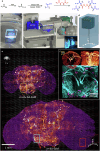
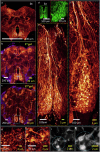

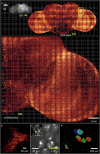
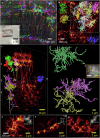
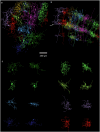
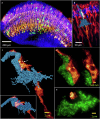


Similar articles
-
Rapid single-wavelength lightsheet localization microscopy for clarified tissue.Nat Commun. 2019 Oct 18;10(1):4762. doi: 10.1038/s41467-019-12715-3. Nat Commun. 2019. PMID: 31628310 Free PMC article.
-
Cortical column and whole-brain imaging with molecular contrast and nanoscale resolution.Science. 2019 Jan 18;363(6424):eaau8302. doi: 10.1126/science.aau8302. Science. 2019. PMID: 30655415 Free PMC article.
-
Quantification of mitochondrial morphology in neurites of dopaminergic neurons using multiple parameters.J Neurosci Methods. 2016 Mar 15;262:56-65. doi: 10.1016/j.jneumeth.2016.01.008. Epub 2016 Jan 14. J Neurosci Methods. 2016. PMID: 26777473 Free PMC article.
-
Expansion microscopy: A powerful nanoscale imaging tool for neuroscientists.Neurobiol Dis. 2021 Jul;154:105362. doi: 10.1016/j.nbd.2021.105362. Epub 2021 Apr 2. Neurobiol Dis. 2021. PMID: 33813047 Free PMC article. Review.
-
Light sheet fluorescence microscopy for neuroscience.J Neurosci Methods. 2019 May 1;319:16-27. doi: 10.1016/j.jneumeth.2018.07.011. Epub 2018 Jul 23. J Neurosci Methods. 2019. PMID: 30048674 Review.
Cited by
-
TRIM29 alleviates intervertebral disc degeneration through the PI3K/AKT/mTOR pathway.Sci Rep. 2025 Jul 10;15(1):24797. doi: 10.1038/s41598-025-10272-y. Sci Rep. 2025. PMID: 40634479 Free PMC article.
-
Multimerized epitope tags for high-sensitivity protein detection.G3 (Bethesda). 2025 Jun 4;15(6):jkaf070. doi: 10.1093/g3journal/jkaf070. G3 (Bethesda). 2025. PMID: 40191928 Free PMC article.
-
A nasal vaccine candidate based on S2 and N proteins from SARS-CoV-2 generates a broad antibody response systemically and in the lower respiratory tract.Immunol Res. 2025 Aug 27;73(1):125. doi: 10.1007/s12026-025-09675-w. Immunol Res. 2025. PMID: 40859051
-
Comparative study of laparoscopic peritoneal vaginoplasty versus sigmoid colon vaginoplasty in the treatment of congenital absence of vagina.Surg Endosc. 2025 Sep;39(9):5907-5915. doi: 10.1007/s00464-025-11868-1. Epub 2025 Aug 5. Surg Endosc. 2025. PMID: 40764452 Free PMC article.
References
-
- Wen, G., Leen, V., Rohand, T., Sauer, M. & Hofkens, J. Current progress in expansion microscopy: chemical strategies and applications. Chem. Rev.123, 3299–3323 (2023). - PubMed
Publication types
MeSH terms
Substances
Grants and funding
LinkOut - more resources
Full Text Sources
Molecular Biology Databases

